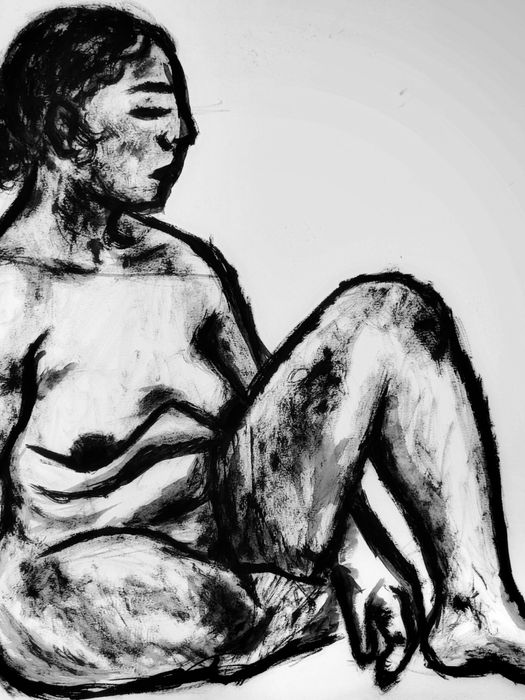top of page

Beaut
This work challenges conventional beauty standards by celebrating the natural form of a voluptuous woman—presented not as an ideal to strive for, but as a reflection of authenticity and truth. Through this piece, the artist embraces and uplifts the body in its fullness, softness, and strength, suggesting that real beauty lies not in conformity, but in simply existing as we are.
By highlighting the curves and presence of the female form, the work reclaims space for bodies that have long been marginalized or edited out of mainstream narratives. It is a statement about nature’s true standard—unfiltered, unshaped by unrealistic expectations, and inherently worthy.
At its core, the piece is about permission: the permission to *just be*, as a woman, without needing to shrink, alter, or explain. It invites viewers to confront their own perceptions of beauty and to recognize the power and grace in forms that are often overlooked.
Through this quiet yet bold portrayal, the artist honours the body not as an object, but as a vessel of existence—valid, whole, and deeply human.
By highlighting the curves and presence of the female form, the work reclaims space for bodies that have long been marginalized or edited out of mainstream narratives. It is a statement about nature’s true standard—unfiltered, unshaped by unrealistic expectations, and inherently worthy.
At its core, the piece is about permission: the permission to *just be*, as a woman, without needing to shrink, alter, or explain. It invites viewers to confront their own perceptions of beauty and to recognize the power and grace in forms that are often overlooked.
Through this quiet yet bold portrayal, the artist honours the body not as an object, but as a vessel of existence—valid, whole, and deeply human.

Lone
This work explores the quiet state of benign solitude—a kind of aloneness that is neither lonely nor distressing, but simply present. It reflects on both the serenity and the challenges that come with spending time alone. Through this piece, the artist acknowledges the dual nature of solitude: its comforting stillness and its occasional emotional weight.
The posture of the figure is central to this narrative—captured in a moment of complete ease, the way one might sit when entirely at peace in their own home. It conveys a sense of familiarity and unfiltered presence, when we are no longer performing, but simply existing.
There is no dramatism or exaggerated gesture—just a quiet, honest portrayal of a state many recognise. The work neither romanticises nor criticises solitude, but instead dwells within it. It says: this is what it feels like to be alone, to feel safe, to feel uncertain, to simply be.
Ultimately, the piece invites viewers to reflect on their own relationship with solitude—to consider what it offers, what it reveals, and how it can hold space for both comfort and vulnerability.
The posture of the figure is central to this narrative—captured in a moment of complete ease, the way one might sit when entirely at peace in their own home. It conveys a sense of familiarity and unfiltered presence, when we are no longer performing, but simply existing.
There is no dramatism or exaggerated gesture—just a quiet, honest portrayal of a state many recognise. The work neither romanticises nor criticises solitude, but instead dwells within it. It says: this is what it feels like to be alone, to feel safe, to feel uncertain, to simply be.
Ultimately, the piece invites viewers to reflect on their own relationship with solitude—to consider what it offers, what it reveals, and how it can hold space for both comfort and vulnerability.

All of Us
This painting explores the tension between visibility and survival in a society that often appears ideal on the surface, yet is saturated with constant judgment and scrutiny. Through vibrant colours and surreal imagery, I depict octopus tentacles and scattered eyes as metaphors for adaptability, alertness, and the emotional labour of existing under watchful gazes. The tentacles, fluid and ever-reaching, represent the need to navigate spaces carefully, to stretch oneself in multiple directions just to stay afloat. The eyes symbolise surveillance—both societal and self-imposed—and the pressure to maintain appearances in a world obsessed with perfection.
Despite this tension, the painting also celebrates resilience and beauty in connection. The colours are intentionally bright and inviting, suggesting that within the chaos, there is still warmth, community, and hope. The fluid composition reflects how we move together, support each other, and find ways to thrive even in systems that try to box us in.
Ultimately, this work is about learning to coexist with discomfort, finding softness in resistance, and recognising the strength that comes from collective presence. It is a reminder that survival itself is an art form—messy, vibrant, and deeply human.
Despite this tension, the painting also celebrates resilience and beauty in connection. The colours are intentionally bright and inviting, suggesting that within the chaos, there is still warmth, community, and hope. The fluid composition reflects how we move together, support each other, and find ways to thrive even in systems that try to box us in.
Ultimately, this work is about learning to coexist with discomfort, finding softness in resistance, and recognising the strength that comes from collective presence. It is a reminder that survival itself is an art form—messy, vibrant, and deeply human.

Lovely Mess
This painting explores the tension between inner light and outer chaos. Soft blends of pink, pastel blue, and green form an ethereal, aurora-like backdrop, evoking a sense of emotional depth, dreams, and quiet wonder. Overlaid is a black, web-like structure—stringy and irregular—suggesting complexity, entanglement, or external pressures. Together, these elements symbolize the contrast between the beauty within and the darker, messier forces that overlay or obscure it. It speaks to the fragility of the inner world and the resilience needed to preserve it. The piece invites viewers to reflect on the coexistence of clarity and struggle in the human experience.
bottom of page